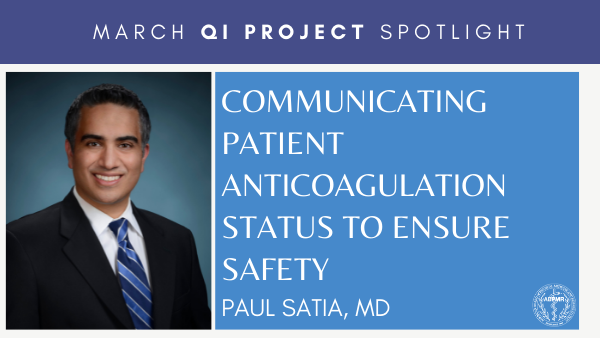CC
QI Spotlight: Communicating Patient Anticoagulation Status to Ensure Safety

The March QI Project Spotlight was submitted by Paul Satia, MD.
In his practice, Dr. Satia found that the anticoagulation status of patients was sometimes not known, and began this project to ensure patient safety during procedures. Dr. Satia and his team created multiple checkpoints so the anticoagulation status was known, reviewed, and communicated to the team by the time a patient's procedure took place. This improved not only the process of understanding a patient's anticoagulation status, but also added to patient safety.
Thank you for submitting your project, Dr. Satia!
The QI Project Spotlight is a periodic feature on the ABPMR News Center to highlight exemplary Quality Improvement projects submitted by your fellow diplomates (or residents) for continuing certification (CC) credit. Diplomates can use the QI Project Spotlight as a tool to plan their own QIs or as a way to connect with other diplomates doing similar work.

What is the problem you are trying to solve?
A cervical epidural steroid injection was about to be performed on a patient who recently started anticoagulation therapy that could have resulted in deleterious consequences. Knowing this information ahead of time could have prevented the patient from being scheduled and placing the patient in harms way. Review of records indicates that there are several steps in which the anticoagulation status of an individual patient is not known, is missed, or is not announced at time of the procedure.
What data (objective measurements) do you have that supports this as a problem?
The anticoagulation status could be missed when:
-
The patient does not indicate the anticoagulants they are taking on their intake form
-
The medical assistants review medications without attention and importance to this specific class of medications
-
The physician reviews the medication list entered by the medical assistant and fails to ask and/or communicate this to the team
-
The nurse doesn't identify this as part of the time out process at the time of the patient's procedure
What is your opportunity statement? State the goal you hope to achieve.
The goals are to create multiple checkpoints to ensure the anticoagulation status is known, reviewed, and communicated to the team by the time the patient's procedure takes place. Considering the goals and unintended consequences, the improvements should be implemented as soon as possible.
What is the underlying cause of the performance/quality problem?
Lack of specific attention to anticoagulation therapy during the intake process, while ordering of the procedure, and at the time-out when the procedure is about to be performed. Common lack of knowledge amongst team members of complications related to bleeding and performing procedures in which they would be otherwise contraindicated.

What change(s) did you implement?
-
Creation of a specific line item on the intake form to identify anticoagulation therapy and any medications, entered by the patient.
-
Review of this line item by the medical assistant and physician, and re-review by the medical assistant on the day of the initial interview when patient's procedure is scheduled.
-
While ordering the procedure, the physician must input this information on the order form. The scheduler verifies anticoagulation status when scheduling a date for the procedure.
-
On the day of procedure, the nurse and physician reviews this specifically with the patient.
-
The nurse announces the patient's anticoagulation status as part of the time-out procedure, which is confirmed by the patient before receiving any anesthesia.

Did you achieve your goal or target from your opportunity statement? What data do you have to support your conclusion?
Yes. A ten-point anticoagulation verification process was created and implemented to ensure patient safety as it relates to performing all procedures who are receiving anticoagulation.

Will you continue with the changes you have implemented?
The goals have been met by the implementation of this ten-point verification process to mitigate chances of performing an unintentional procedure whilst the patient is anti-coagulated, in which the procedure itself may be contraindicated. Staff re-education at frequent intervals to stress the importance of reviewing this specific item may deter potential complications from occurring, and stress the importance of anticoagulation therapy as it relates to interventional procedures.



